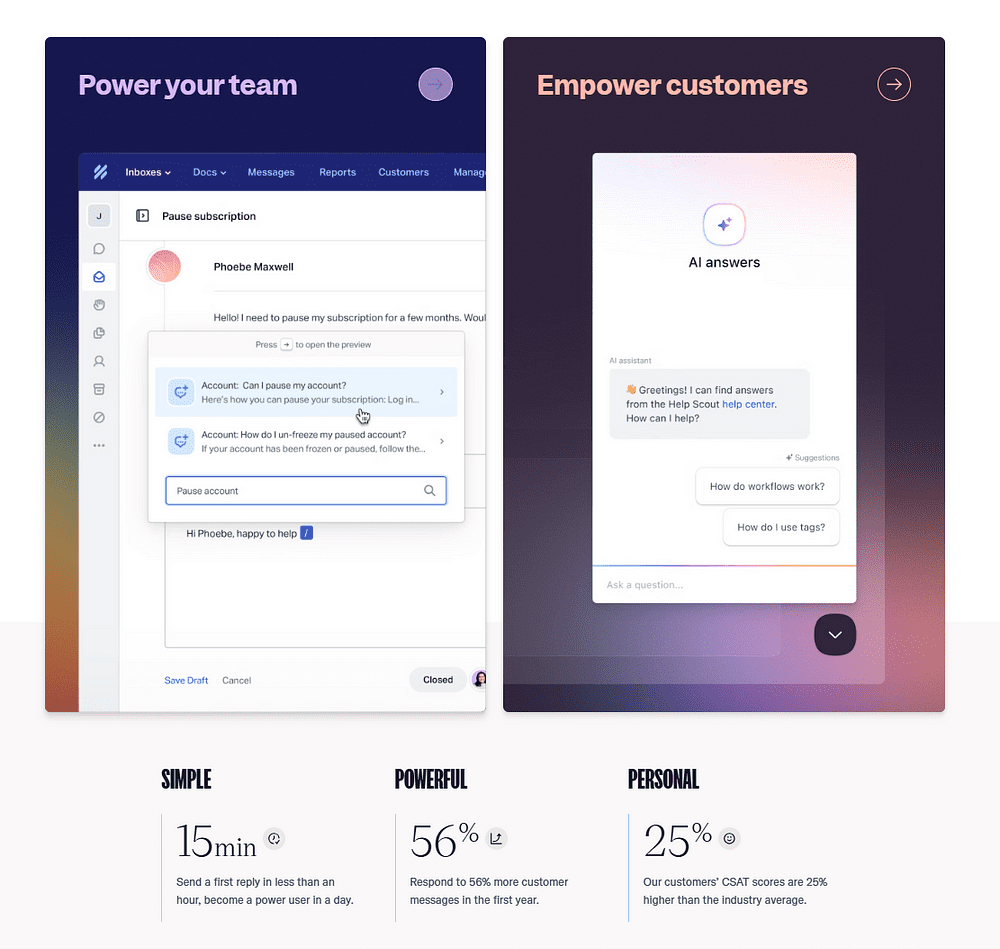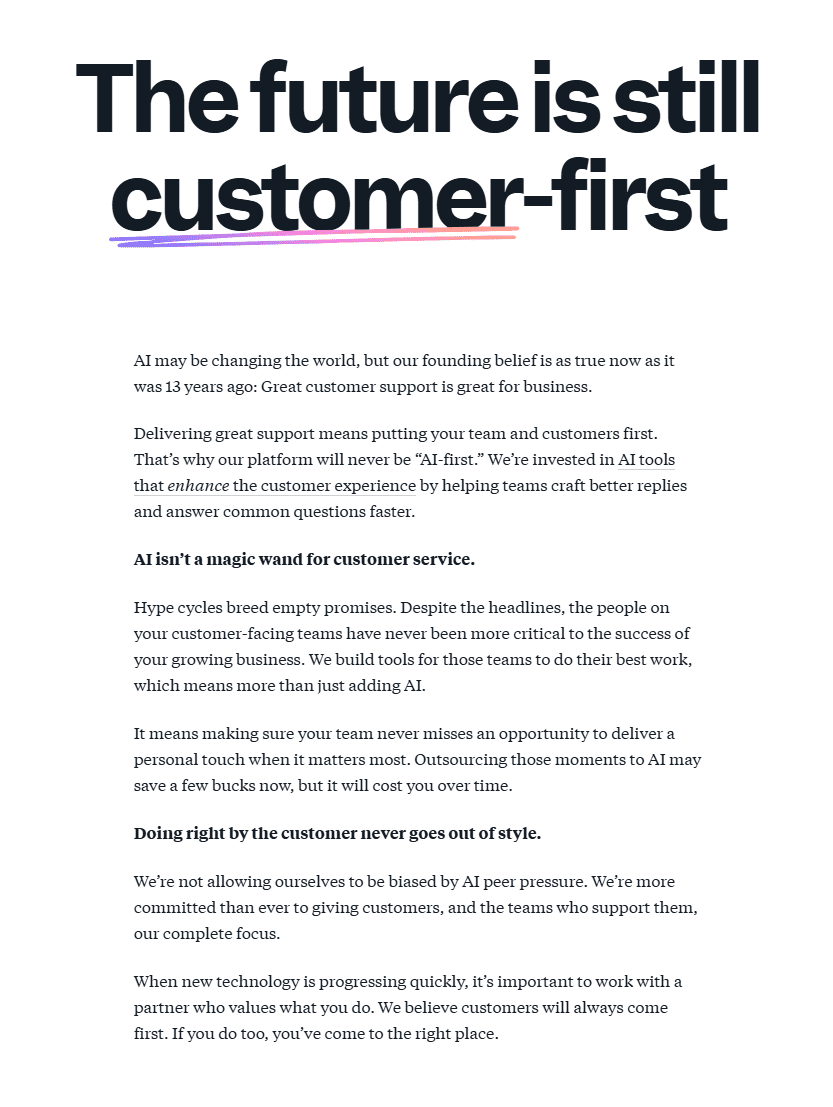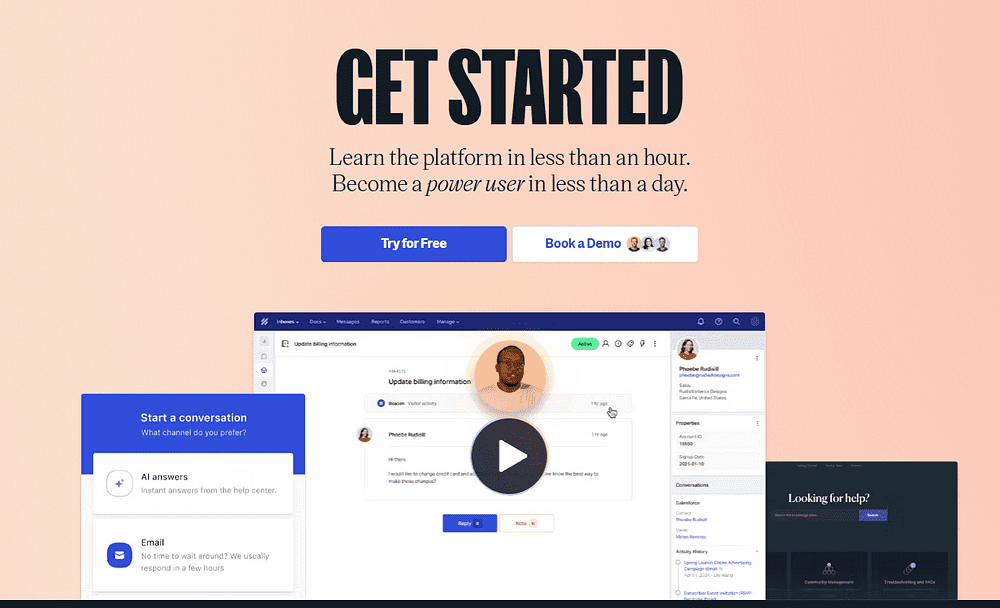How Help Scout Is Transforming Your Customer Service Experience While Keeping It Human. In an age where customer service often feels increasingly automated and impersonal, you’re likely searching for ways to maintain meaningful connections with your customers while still managing growing support volumes. The challenge isn’t just handling inquiries efficiently — it’s doing so in a way that makes customers feel valued rather than processed. This delicate balance is precisely what Help Scout, founded in 2011, set out to address with its customer communication platform.

Unlike traditional helpdesk systems that transform people into ticket numbers, Help Scout has built its reputation on facilitating authentic customer relationships. With more than 12,000 customer-facing teams using its platform and over 950 million customer conversations facilitated to date, this remote-first company has clearly struck a chord with businesses that refuse to sacrifice the human element in their support strategy.
But in a crowded market of customer service tools, does Help Scout truly deliver on its promise? Let’s dive into what makes this platform unique, how it compares to alternatives, and whether it might be the solution your team has been looking for.
Understanding Help Scout’s Human-First Philosophy
Before examining Help Scout’s features, it’s essential to understand the philosophy that shapes its entire approach. According to Nick Francis, Help Scout’s CEO and co-founder, the company was built on the premise that “customer service is a human experience that technology should enhance, not replace.”
This fundamental belief guides everything from product development to pricing structure. Unlike competitors that charge per user — often leading companies to limit access and create information silos — Help Scout offers plans with unlimited users. This approach encourages collaboration across departments and ensures everyone in your organization can contribute to the customer experience.
“The problem with most helpdesk software is that it was designed for IT departments tracking internal issues, not for customer-facing teams building relationships,” Francis explained in a recent interview with TechCrunch. This insight led Help Scout to develop a platform that prioritizes conversation over case management.
The human-first philosophy extends to Help Scout’s own organizational structure as well. Operating with a fully remote team across more than 115 cities globally, the company embraces diversity of thought and experience. This distributed approach allows them to better understand the global nature of customer support and the varied challenges faced by their diverse customer base.

Core Features That Set Help Scout Apart
Help Scout’s platform consists of five core components, each designed to enhance your customer communication while maintaining that crucial personal touch:
Shared Inbox
The centerpiece of Help Scout’s offering is its collaborative email management system. Unlike traditional email, the shared inbox allows your team to work together seamlessly without duplicating efforts or leaving customers waiting.
Key capabilities include:
- Collision detection that prevents multiple team members from responding to the same customer
- Internal notes that allow for behind-the-scenes collaboration
- Custom workflows that route conversations to the right specialists
- Performance reporting that helps identify bottlenecks and coaching opportunities
What you won’t find are impersonal ticket numbers in subject lines or robotic autoresponders that make customers feel like they’ve entered a support queue rather than started a conversation.

Self-Service Knowledge Base
Help Scout’s Docs feature allows you to create a searchable knowledge base that empowers customers to find answers independently. Unlike static FAQ pages, Docs is designed to be a living resource that evolves with your customers’ needs.
The platform provides insights into what information customers are searching for and where they’re encountering gaps in your documentation. This intelligence helps you continuously improve self-service options while reducing repetitive inquiries for your team.
Live Chat
When customers need immediate assistance, Help Scout’s Beacon chat feature provides real-time support without sacrificing personalization. Unlike standalone chat tools, Beacon integrates seamlessly with your knowledge base and shared inbox, giving support agents full context for each conversation.
The chat interface is designed to feel welcoming rather than transactional, with custom branding options and the ability to show real team member profiles rather than generic support avatars.

Proactive Messaging
Help Scout enables you to reach out to customers before they encounter problems, with targeted messages based on behavior, account status, or other triggers. This proactive approach allows you to guide customers through complex processes, announce relevant updates, or simply check in to ensure satisfaction.
Unlike intrusive pop-ups that interrupt the user experience, these messages can be designed to appear at contextually appropriate moments, providing help exactly when it’s most valuable.
Automation and Workflow Tools
While maintaining the human touch is crucial, Help Scout recognizes that some tasks are better handled through automation. The platform includes tools to streamline repetitive processes without making customers feel like they’re interacting with robots.
These include saved replies (that can be customized before sending), automatic routing based on message content, and follow-up reminders to ensure no conversation falls through the cracks.
Navigating the Shared Inbox: Collaboration Without Confusion
For most customer-facing teams, email remains the primary support channel — but traditional email platforms weren’t designed for collaborative work. Help Scout’s shared inbox transforms email from an individual tool into a team resource without losing the personal connection customers expect.
When a customer message arrives, it’s visible to your entire team, but Help Scout’s traffic cop feature prevents duplicate responses. You can assign conversations to specific team members, add private notes with relevant context or suggestions, and even bring in specialists from other departments for complex issues — all invisible to the customer.
What makes this approach particularly effective is that customers never see the machinery behind your support operation. From their perspective, they’re simply having an email conversation with a helpful human being, not navigating a complex support system.
Recent updates to the shared inbox include enhanced filtering options that allow you to create custom views based on any combination of criteria. This means you can easily prioritize urgent issues, identify conversations at risk of violating SLAs, or focus on specific customer segments.
“The shared inbox transformed how our support team collaborates,” explains Sarah Hatter, founder of CoSupport and author of “The Customer Support Handbook.” “Before Help Scout, we had people checking specific email addresses, which created knowledge silos and inconsistent responses. Now everyone can see everything, learn from each other, and provide more consistent support.”
Building Self-Service That Actually Works
While direct communication is valuable, the most efficient resolution is one where customers can immediately find their own answers. Help Scout’s Docs feature helps you build a knowledge base that customers actually want to use.
Unlike many knowledge base solutions that feel disconnected from the rest of the support experience, Docs integrates directly with Help Scout’s other features. This means when a customer starts typing a question in chat, relevant articles can appear automatically, potentially resolving their issue before they even submit an inquiry.
The platform provides detailed analytics on which articles are most viewed, which search terms return no results, and how effective each piece of content is at resolving issues. This intelligence allows you to continuously refine your knowledge base to better meet customer needs.
A particularly useful feature is the ability to create internal-only content. This allows you to maintain standard operating procedures, troubleshooting guides, and other resources for your team in the same system where you manage customer-facing documentation.
“The key to effective self-service isn’t just having a knowledge base — it’s having one that evolves based on actual customer needs,” notes Matthew Klammer, Customer Success Manager at Help Scout. “When you see what customers are searching for and can’t find, you’ve identified your next five knowledge base articles.”

Real-Time Support: When Your Customers Need You Most
While email and self-service handle many support scenarios effectively, some situations demand immediate assistance. Help Scout’s Beacon chat function provides real-time support without forcing you to manage yet another disconnected tool.
What sets Beacon apart from standalone chat solutions is its deep integration with your existing knowledge base and conversation history. When a customer initiates a chat, your team can immediately see:
- Previous conversations across all channels
- Which help articles they’ve already viewed
- Account details and custom properties
- Which pages they’ve visited on your site
This context allows for more personalized and efficient support, eliminating the frustrating “please explain your issue again” experience that customers dread.
Beacon also includes an innovative “Suggested Articles” feature that recommends relevant knowledge base content based on the chat message, potentially allowing customers to resolve simple issues without waiting for an agent.
For teams concerned about managing another real-time channel, Help Scout offers flexible configuration options. You can limit chat availability to specific hours, automatically route chats to appropriate team members, or even use chat primarily as an enhanced content delivery system while still handling complex issues via email.
Help Scout vs. The Competition: Finding Your Perfect Fit
The customer support software landscape is crowded with options, each with distinct strengths. Understanding how Help Scout compares to major competitors can help you determine if it’s the right fit for your specific needs.
Help Scout vs. Zendesk
Zendesk pioneered the modern helpdesk and offers a comprehensive suite of enterprise support tools. While powerful, its ticket-based approach and complex administration can create a more mechanical customer experience.
Help Scout shines for teams that prioritize conversation over case management and prefer a simpler, more intuitive interface. It typically appeals to companies that want powerful tools without sacrificing the personal touch or dealing with complex implementation.
Cost-wise, Help Scout can be significantly more economical, especially for growing teams, thanks to its unlimited user approach rather than per-seat pricing.
Help Scout vs. Intercom
Intercom built its reputation on messenger-based customer engagement and offers robust marketing automation alongside support features. Its strength lies in proactive communication and lead generation.
Help Scout focuses more specifically on customer support excellence, with email as the primary channel rather than chat. Teams that handle complex support issues, require detailed collaboration, or serve customers who prefer email often find Help Scout’s approach more suitable.
Help Scout vs. Freshdesk
Freshdesk offers a ticket-based system with multi-channel support at competitive price points. It provides solid functionality for teams transitioning from email to their first helpdesk system.
Help Scout differentiates itself with a more streamlined experience, avoiding typical helpdesk conventions like ticket numbers and complex status workflows. Companies that want powerful support tools without the traditional “ticketing system” feel often prefer Help Scout.
Help Scout vs. Gorgias
Gorgias specializes in e-commerce support with deep integrations into platforms like Shopify and Magento. Its strength lies in connecting customer support directly to order management.
While Help Scout serves many e-commerce businesses, its approach is more channel-agnostic. Companies that support customers beyond just order issues or operate outside the e-commerce space typically find Help Scout more versatile.
According to recent analysis by G2, Help Scout consistently scores higher than competitors in categories like “Ease of Use,” “Quality of Support,” and “Ease of Setup,” while typically scoring slightly lower in “Breadth of Features” compared to all-in-one enterprise platforms.
Scaling Support While Maintaining Quality: Customer Success Stories
The true test of any support platform is how it performs in real-world scenarios. Looking at how diverse organizations use Help Scout provides insight into its versatility and effectiveness.
E-commerce: Bombas
Bombas, the comfort-focused sock and apparel company with a buy-one-give-one model, uses Help Scout to manage high-volume support while maintaining their commitment to exceptional customer experiences.
“We handle thousands of conversations weekly, but each customer still feels like they’re getting a personalized response,” explains James Williams, Head of Customer Happiness at Bombas. “Help Scout’s workflows allow us to route inquiries efficiently while their reporting helps us identify trends and improve our products.”
Bombas particularly values the ability to collaborate internally on complex customer issues without the conversation feeling disjointed from the customer’s perspective.
SaaS: Buffer
Buffer, the social media management platform, operates with a globally distributed team serving customers across every time zone. They use Help Scout to ensure seamless handoffs between team members.
“The ability to leave internal notes and see the complete conversation history allows our team members to pick up conversations naturally, even if they weren’t involved initially,” says Åsa Nyström, VP of Customer Advocacy at Buffer. “Customers never feel like they’re starting over, even when talking to someone new.”
Buffer also leverages Help Scout’s API to connect support data with their product development workflow, ensuring customer feedback directly influences their roadmap.
Education: Teachable
Teachable, an online course creation platform, supports both course creators and their students through Help Scout.
“We have distinct support needs for our creators versus their students,” explains Allie Dyson, Customer Care Manager at Teachable. “Help Scout’s tagging and reporting features allow us to track both types of inquiries separately while maintaining a unified approach to quality.”
Teachable particularly values the knowledge base features, which allow them to create both general and account-specific resources that reduce repetitive questions.
Conclusion: Is Help Scout Right for Your Business?
After examining Help Scout’s features, philosophy, and real-world applications, the question remains: Is this the right platform for your customer support needs?
Help Scout is likely an excellent fit if:
- You value conversation and relationship-building over ticket processing
- Your team collaborates frequently on customer issues
- You’re growing and need a platform that scales economically (with unlimited users)
- You want powerful tools without overwhelming complexity
- You believe in the importance of the human element in customer support
Conversely, Help Scout might not be ideal if:
- You require extensive customization of support workflows
- Your primary support channel is phone rather than email or chat
- You need deep integration with specialized enterprise systems
- You’re looking for an all-in-one platform that includes robust marketing automation
What distinguishes Help Scout in the crowded customer support landscape is its unwavering focus on keeping human connection at the center of service interactions. In a world increasingly dominated by chatbots and automated systems, this commitment to authentic communication represents a refreshing alternative — and potentially a significant competitive advantage for businesses that share this philosophy.
As AI and automation continue to transform customer service, Help Scout’s approach serves as a reminder that technology should enhance human capabilities rather than replace them. The most successful support teams will be those that leverage powerful tools while preserving the authentic connections that build lasting customer relationships.
Ready to Humanize Your Customer Support?
If Help Scout’s approach to customer communication resonates with your values and business needs, the next step is seeing the platform in action. Visit Help Scout’s website to schedule a demo or start a free trial to experience firsthand how their tools can transform your support operations while keeping the human touch that customers increasingly value.


